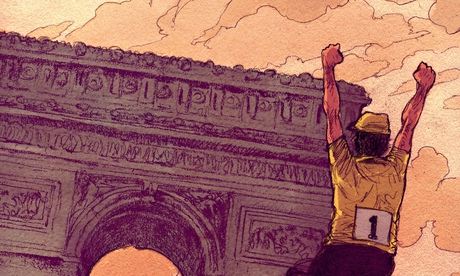
The 2014 Tour de France begins in Leeds on 5 July, which is pretty exciting if you're a cycling fan. But what to do if you're not? Well, here's one idea: why not take a look at Legends of the Tour by the Dutch illustrator (and amateur racing cyclist) Jan Cleijne? Personally, I think it's perfectly possible that this exquisite comic book will convert you overnight to the cause of the yellow jersey. But even if it doesn't, imagine how impressed the office cycling bores will be with all your new-found knowledge (it took me less than an hour to read it). "Oh, yeah," you'll be able to mutter ever-so-casually as you peel the lid off your morning coffee. "Yesterday was just like Bernard Hinault in '79, wasn't it?"
Cleijne tells the story of the Tour in 10 chapters, kicking off with its beginnings in 1903 as a race to promote the French sports newspaper L'Auto (the first Tour was won by Maurice Garin, who was cheered by 10,000 people as he took his victory lap; Garin finished two hours and 49 minutes ahead of the next competitor, still the largest gap between first and second places in the race's history).
Sketched entirely in sepia tones, these early pages are a marvel. The French countryside, all cypress trees and bar tabacs, looks exactly as it does in old postcards, while Cleijne's moustachioed heroes seem to have come straight out of the cycling equivalent of Chariots of Fire (Rene Pottier, who won in 1906, stopped for a glass of wine en route to Nice). The frames that show hunched cyclists doggedly climbing the Pyrenees (the Tour first entered the mountains in 1910) are so crazily evocative, I fancied I could feel my calves beginning to ache!
Then, like the lights suddenly coming on, colour: when the Tour resumed after the war, in 1919, the leader began wearing a yellow jersey (L'Auto was printed on yellow paper). Cleijne now clicks through all the famous rivalries: the Italians Bartali and Coppi jostling for position in 1949; Poulidor and Anquetil's epic battle on the Puy de Dôme in 1964; Hinault and Zoetemelk head-to-head on the Champs-Elysées in 1979. The great Belgian Eddy Merckx is here, of course, and Greg LeMond and Bradley Wiggins. But there are shadows, too: Tommy Simpson's death at the age of just 29 on Mont Ventoux in 1967; Lance Armstrong's seemingly compulsive doping (Cleijne gives the reader a sharp sense of the scale of this by juxtaposing liverish frames of the American injecting beside those depicting every one of his seven consecutive Tour de France "victories"). I loved the story of Wim van Est, a Dutch rider who in 1951 fell down a mountainside and was rescued using a "rope" made from knotted inner tubes.
Oh, what a fantastic book this is. Not only is it a wonderfully concise history of the Tour, its competitors' stoicism and skullduggery displayed to compelling effect, it is quite ravishing to behold. I adored it – and the last time I rode a bike, I was on my way to take my finals.

